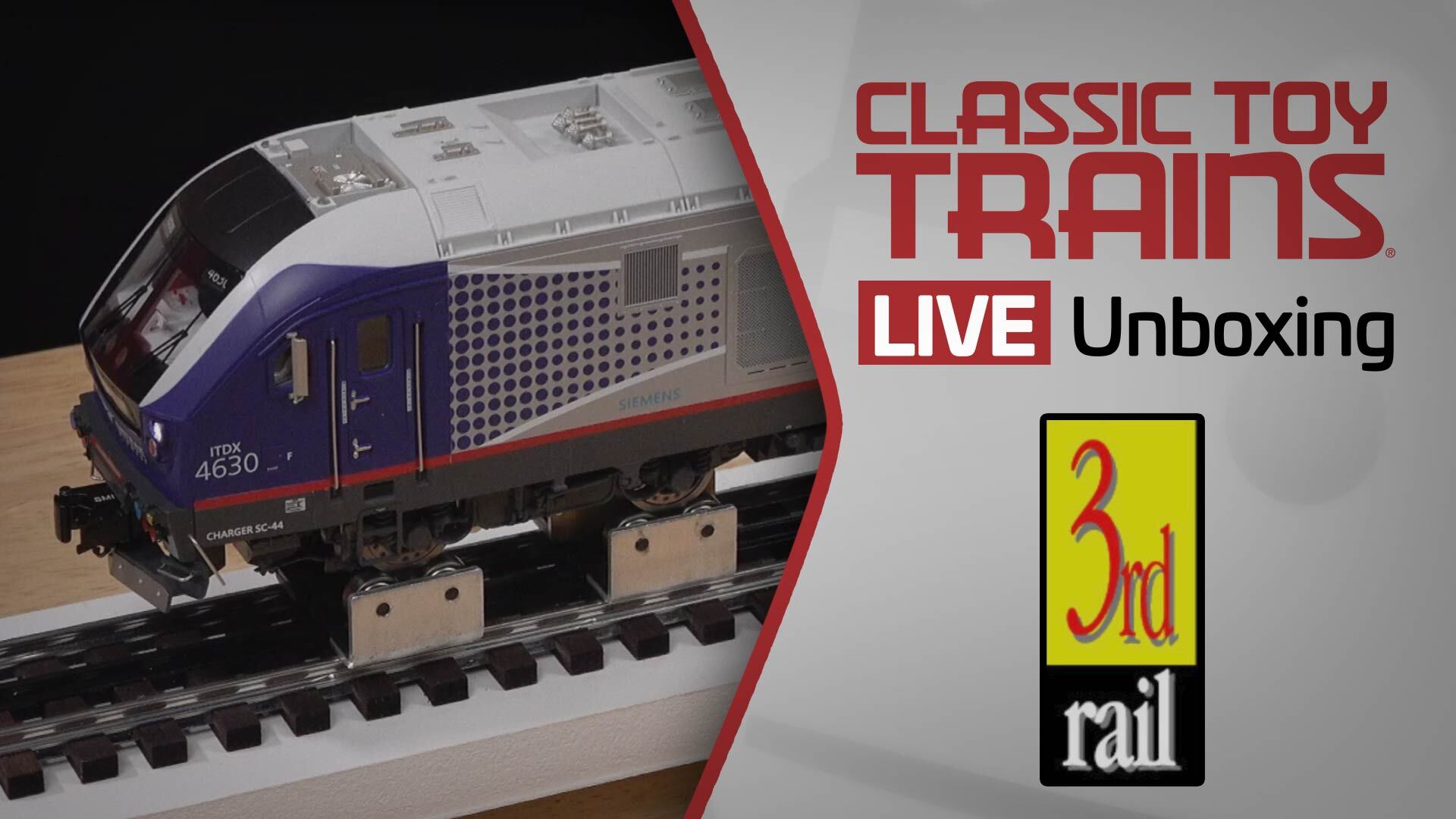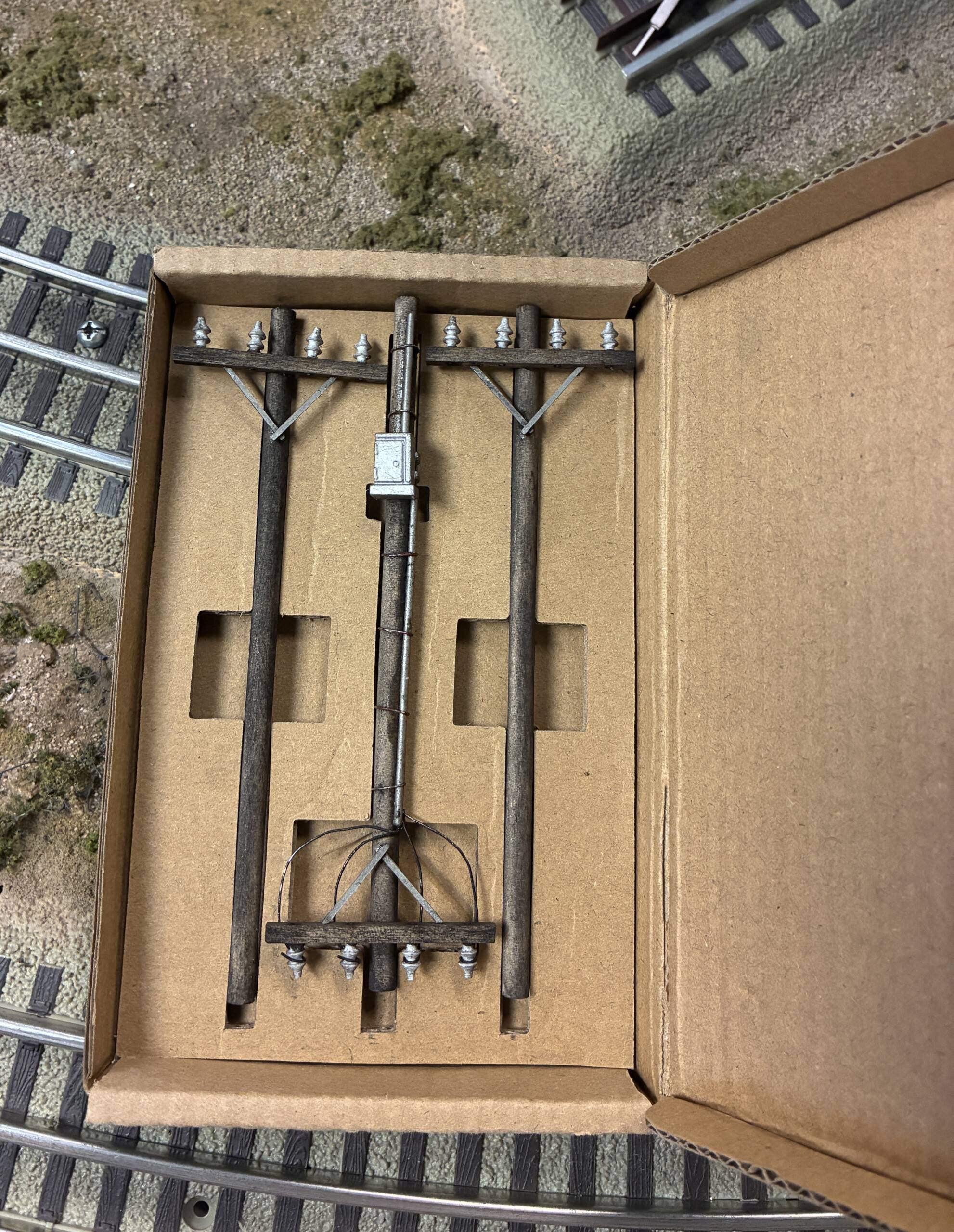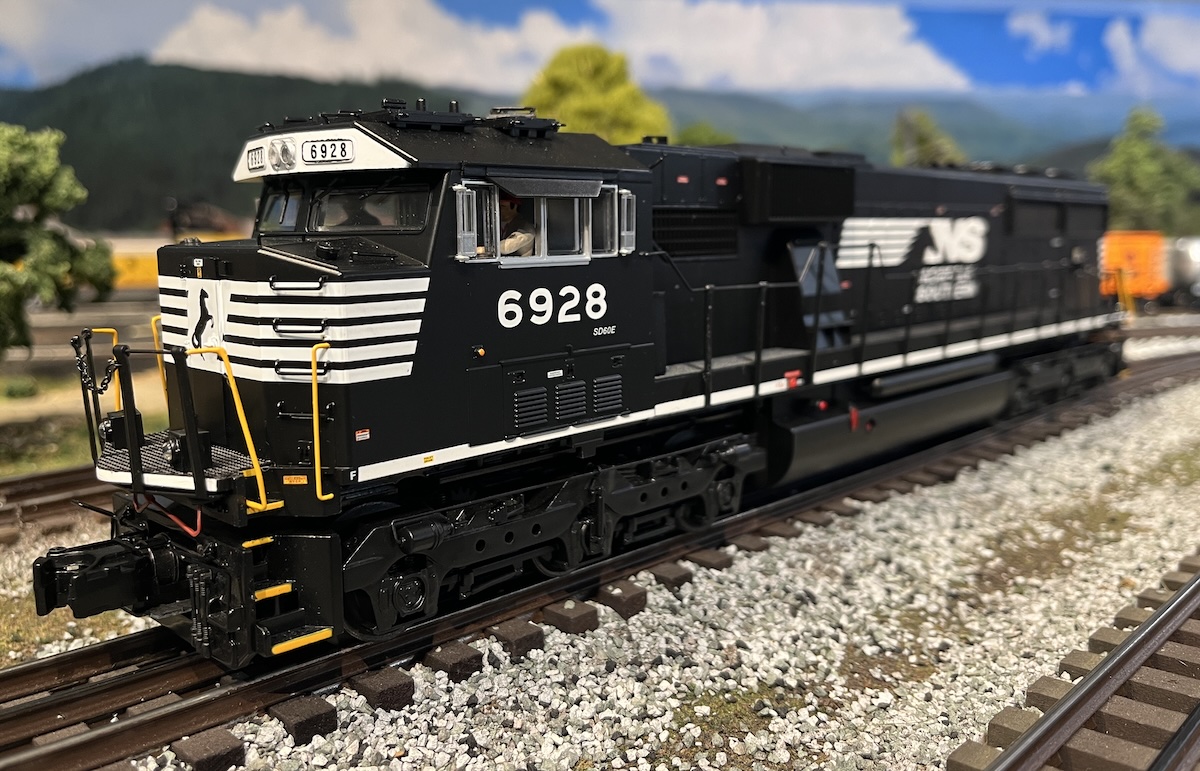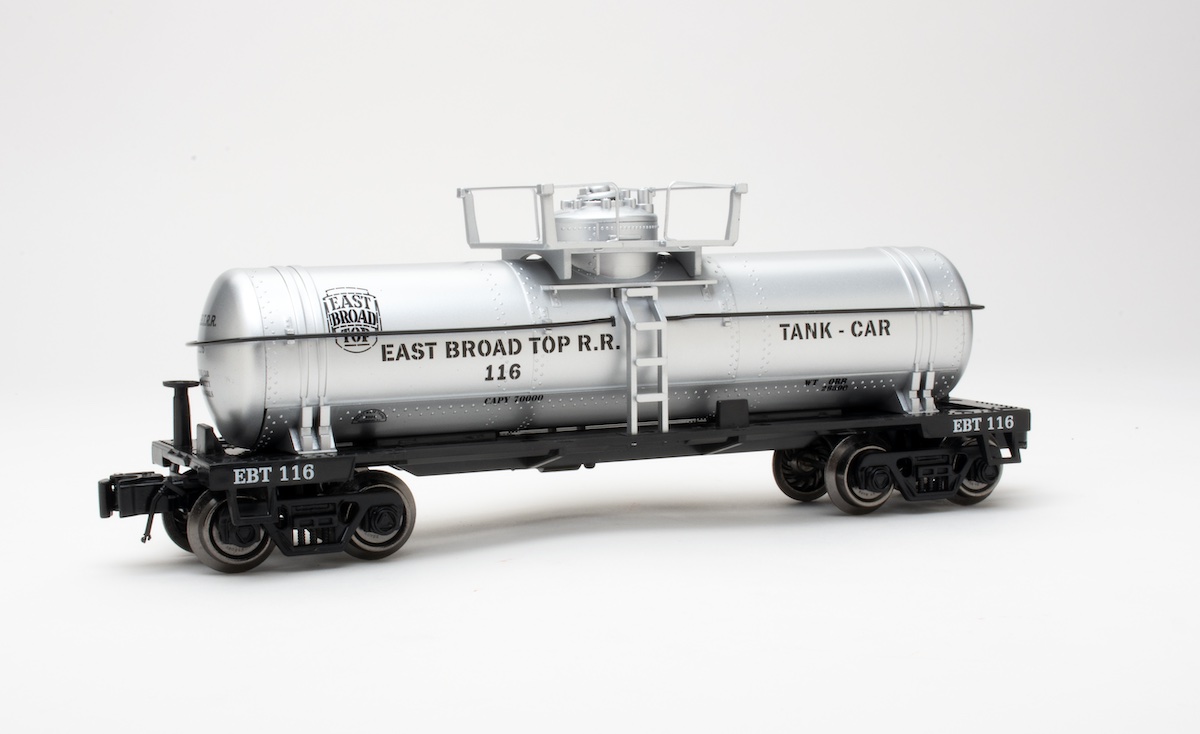In the late 1950s, Tropicana used the world’s only sea-going juice tanker to move the breakfast beverage between Cape Canaveral, Fla., and New Jersey. Railroad operations, however, proved to be more time responsive and cost effective, and the Juice Train was launched in 1970. It has become one of the most tightly scheduled (and reliable) trains in operation.
The Juice Train was picked up by Penn Central from the Seaboard Coast Line and shuttled to New Jersey under the old Pennsy wire. The locomotive modeled in this set, the Pennsylvania RR’s E44 electric locomotive, was a General Electric development of its 1956-vintage 3,300-horsepower E33 which the firm built for the New Haven.
The 4,400-horsepower locomotive was an improvement over the earlier design, but not an evolutionary leap. GE’s attempt to deliver a cost-effective locomotive by not starting development from the ground floor resulted in a successful and reliable product that survived the Pennsylvania, the Penn Central, and even made it into Conrail.
When Conrail phased out freight electrification, some E44s were purchased directly by Amtrak. A few others passed through the hands of NJ Transit.
This new lease on life was short-lived, because the E44s were not good for hauling passenger or commuter trains.
Opening the box
The sight of Penn Central locomotion is not something that stirs a great deal of ‘what if’ daydreaming in the heart of this three-railer.
Being kind, Penn Central was like the aftermath of a frat house party where only Wild Turkey and Reunite were served as beverages. Penn Central was a mess. Fortunately, this O gauge “Brick” looks so nice, you would never know the line was a basket case.
The E44 lives up to the Brick nickname. Long, squat, and solid, it can be envisioned as simply a motorized garden paver. Forget European-style electrics that look like a friendly toaster. Back in the day, this locomotive symbolized what the future of electrified freight hauling would be.
The model has sharp angles, as you’d expect. The face is flat, but it possesses some surprising details: footboards and brake/multiple unit (MU) lines, two red electrical lines coming out of receptacles (there are six of these on the nose) on the midsection of the nose and connecting with other receptacles on the nose.
I was surprised to see a drawbridge and safety chain because there isn’t a front pilot deck. But there is a doorway in the nose of the model, a detail obscured by the black paint. This was a cool detail to include, because it is easy to forget that the real locomotive’s door was functional, not just for decoration.
The illuminated number boards arc forward, coming to a peak with the two-lens headlights. Two marker/classification lights dot each corner.
The cab steps rise straight up on either side of the short nose. There are two grab irons angle-mounted on the snout. The cab has crew figures, wiper arms on the fore and aft windows, silver-trimmed plastic window frames, and two movable windscreens.
The body is plastic. I think this might be the first plastic Premier line electric I’ve encountered. On the sides, the cast-in rivet and hinge detail is good. There are see-through screens.
Above the cab, you’ll find the pantograph rig. Unlike the metal assembly that we’re used to on electric locomotives such as the GG1, there are two individual single arm units, merely co-located on the roof.
The roof has cast-in rivet and lift ring detail. There are also see-through screens on either side of the body in the rearmost quarter of the shell.
The rear of the model mirrors the front, save that there is a pilot deck (the red wires go from receptacle to receptacle, but they drape over the deck).
As for the decoration, the Penn Central scheme is only mildly more exciting than a black locomotive with no lettering at all. The black paint really obscures cast-in details (as noted by my surprise to see that there were doorways on the ends), but that is the nature of the beast.
The base black coating of paint was satisfactory, but there were a few spots where I though it might have been applied too deeply and came close to obscuring the rivet detail.
The white lettering was neat and clean, but the PC logo was wrong. The “P” and the “C” connect. This is true for the large emblems on both sides and the smaller emblems on the noses.
I had to think about it for a bit. Was too much paint applied, or was it an error in the design?
In the end, I concluded that the design was probably in error. The paint seemed to be too neatly applied for it to have been a masking or overspray error.
But, as one office wag noted, “But hey, it’s the Penn Central. Who’ll notice?”
The rolling stock
The train set is comprised of four 50-foot double-plug-door boxcars decked out in Tropicana colors as well as a Penn Central N8 caboose.
All of the rolling stock is workmanlike Premier-line gear. The cars feature die-cast metal trucks and couplers, add-on details such as brake wheels, undercarriage detail, and solid graphics.
The double-door plugged cars look terrific. The design is common enough to look at home on a 1970s layout or a 21st-century model railroad.
The body has cast-in rivet and structural support detail. The doors are add-on, which is not what my initial impression was. The double doors were so tight against the body – sort of like how a plugged-door boxcar would be – I was surprised that they actually opened.
You’ll also find add-on ladders on the four corners, and a brake wheel and chain on one end. An add-on step is positioned above the couplers (to allow brakemen to safely go from one side of the car to the other). The car has undercarriage brake and support detail.
The die-cast couplers have magnetic openers. Brake lines dangle next to the coupler. Metal trucks are sprung, contrasting with the caboose, which has simple die-cast metal side frames.
The Tropicana brand graphics in their green, orange, and black colors look good, and all the nomenclature data is cleanly applied to the body.
The car also has a multi-colored placard for Automatic Car Identification (ACI). This was an optical scanning system used in the 1960s and ’70s as a pioneering attempt to enable railroads to track rolling stock. It was far from successful and was withdrawn from service in the late ’70s. You may still see an occasional ACI placard on a rusted-out hulk rolling through a town near you.
Bringing up the rear of the train is the N8-class caboose, which is pretty nice. The car has marker lights as well as interior decoration, a crew figure, and illumination. There are add-on rooftop walks, and grab irons on the ends and sides of the decks as well as the top of the cupola.
There are two power pickup rollers approximately 4 inches apart. Unlike the couplers on the boxcars, these are the thumbtack-style magnetic couplers.
As readers of my reviews may note, I don’t nitpick a lot about minor details. However … the crewman in the cupola is facing the end of the car with the marker lights. Unless the crewman is paranoid about a train sneaking up on him, methinks the crewman was incorrectly installed in our sample.
As for the car’s decoration, the Penn Central green evokes memories the New York Central’s jade green. It was neatly applied, and it contrasts nicely with the black of the roof.
The Penn Central lettering is clear and crisp, and the side of the car has a multi-colored ACI placard.
On the test track
I was a bit surprised by the sound when I powered the model up for the first time. Maybe it was the pre-set volume level, and certainly the speaker helped, but the thrum of the electric motor was impressive.
And a Kalmbach employee passing by the workshop stuck his head in to see what piece of machinery was running.
I did expect the model to have self-operating pantographs, but it has what the MTH catalog calls them “Mechanically operating” pantographs – code for “use your finger” to lift them up.
The locomotive responded to all commands in a flash, and the ProtoSound 2.0 functions that we tested all did what they were supposed to do, from checking the “mileage” on the locomotive to opening the couplers.
Our low-speed average was 2.3 scale miles per hour, and our high-speed average was 71 scale miles per hour. Drawbar pull was 2 pounds.
In spite of the murky PC logo, this model would have done the real Penn Central engine proud. It was responsive and pulled anything we put behind it (which included every freight and passenger car we had in the office that would fit on the test track).
So in the end, I was pleased with this outfit. The Premier line MTH Tropicana set acknowledges a fine example of a modern corporate unit train. The outfit is a good operator and is priced right. In my book, it was like buying the locomotive and getting the five cars for free. You can’t beat that with a stick.
So go down to your MTH retailer to check out this 1970s icon.
Price: $529.95 (20-5603-1)
Features: O-42 operation, set has an E44 electric-profile locomotive and a five-car train – four boxcars and a caboose. The locomotive features two can-style motors, ProtoSound 2.0, and coil couplers. Rolling stock has die-cast metal trucks and couplers. Caboose has interior lighting and marker lights.















That sure is one square engine!